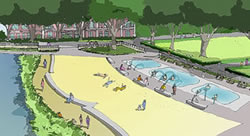Lottery Says Yes to Bishop's Park Beach
Multi million pound funding for restoration scheme
Ambitious plans to create an urban beach in Bishop's Park and renovate the grounds of the adjoining Fulham Palace are set to become a reality after the Heritage Lottery Fund awarded the scheme £3.65 million.
The Heritage Lottery Fund and Big Lottery Fund announced on Wednesday March 31 that Bishop's Park is one of six across England which have been chosen to receive a total of £31 million.
The Heritage Lottery Fund said: " The gardens of Fulham Palace are amongst the most important in the country and were once surrounded by the longest moat in England. The grounds were made famous in the 16th century when grapes were cultivated there and sent to Queen Elizabeth I by Bishop Grindal.
" Bishop’s Park officially opened in 1893 and included land known as Bishop’s Walk, Bishop’s Meadow and West Meadow.
" The Parks for People grant will enable these two pieces of parkland to be reunited through the restoration of the existing landscape and buildings.
"Volunteering opportunities and activity programmes will also help involve the local community in the day-to-day running of the park."
Bishop's Park first had a beach in Edwardian times. Opened in 1903, it was dubbed Margate Sands as the sand was brought from Margate and other beaches in Kent, and proved a huge attraction for visitors. However it fell into disrepair during the Second World War and was closed in 1949.
Now, as well as returning the seaside atmosphere to the park, the the Lottery funds will help Hammersmith and Fulham Council to restore the famous Fulham Palace grounds. The walled garden and vinery will be restored and the stables turned into an education centre.
The Fulham Palace moat, thought to be the longest medieval moat England, will be partially excavated by the palace's Gothic Lodge, which will also be repaired.
April 2, 2010
Related links
|
